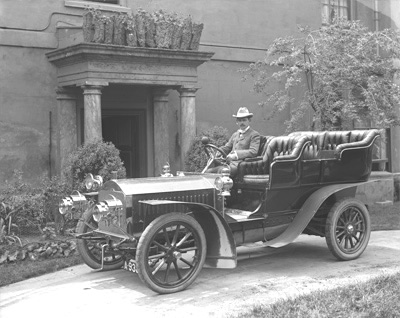 |
Negative No: Laf4814 Dated 16-06-1905 |
At the age of 23, he inherited great wealth and became the proprietor of the Battersea Flour Mills. He was educated at Harrow and entered a military career, which ended in 1899 with his commission as Lieutenant. Already an enthusiast of motoring, by 1902 he was referred to in the press as “a gentleman well known personally and by name to automobilists throughout the kingdom.” Cars indeed featured very much in his private, business and public life!
Mayhew had experience with many types of motor vehicles since the inception of the movement. Privately he was the owner of, and drove, Benz, Panhard, Mors, New Orleans and Napier cars. He confessed in Motoring Illustrated: “I usually keep three or four cars, and every year I have a clear out, substituting later types.” In May 1902, he spent what was probably the first recorded motoring honeymoon – in Wales. Soon afterwards his wife was photographed behind the wheel of her very own Baby Peugeot and the 7 hp Panhard!
In April 1900 he had participated, in an 8 hp Panhard, in the first 1000-mile Reliability Trial and two years later, driving a 35 hp Napier, he took part in the famous Paris-Madrid race. In the same year, again driving a Napier, he narrowly missed qualifying for the Gordon Bennett Trophy. The next year, on a powerful 80 hp racing Napier, he failed to qualify again! What he gained, however, was a life-long friendship with other fellow racing figures – the Hon. C.S. Rolls and S.F. Edge.
In May 1902, the first of five 16 hp Napier lorries with 5 ton capacity was delivered for his flour milling business, replacing horse-drawn wagons and reflecting the waning efficiency of real horse power.
As a founding member and a vice-president of the Automobile Club of Great Britain and Ireland (ACGBI), and a chairman of the Highways Committee on board of the London City Council he had fought tiressly for the recognition of the new mode of transportation. On this subject he wrote an article for The Car Illustrated of June 1902 entitled “A Coming Revolution”, in which he prophesied the future with no horses, no smell on the streets, less road repairs and the faster delivery of goods.
His military training allowed him to spot an additional advantages presented by the car in the service of the army. To prove it, he and his automobilists friends placed themselves at the disposal of the military authorities for motorised duties. Their success paved the way for the creation of British Motor Service Volunteer Corps (BMSVC), commanded by Meyhew himself, who was then promoted to Lieutenant Colonel.
When World War I broke out, twenty-one members of BMSVC went to France to assist the British Expeditionary Force. For his services Mayhew was awarded the O.B.E. In November 1904 the BMSVC celebrated its second anniversary. It had 155 members, who in the previous year had carried out 1,289 duties. In June 1905 the King commanded 24 of them, by now looking gallant in their own uniforms, to be present at the Aldershot review held for the King of Spain – himself a keen motorist.
In August 1905 Mayhew led a cavalcade of fifty motor cars, taking the visiting French Naval Officers for excursions around the country. For this event he used a four-cylinder, 40 hp live axle drive Napier car, as seen in the Lafayette photograph.
Mayhew was a firm supporter of the British-manufactured Napier petrol cars long before the Gordon Bennett Trophy of 1902 and let it to be known by allowing his name being used in the firm’s promotional material. In May 1902 the Napier advert proudly stated: “[Mr Mayhew] thinks that Messrs. Napier are in the forefront of English makers, and likely to remain there!”
